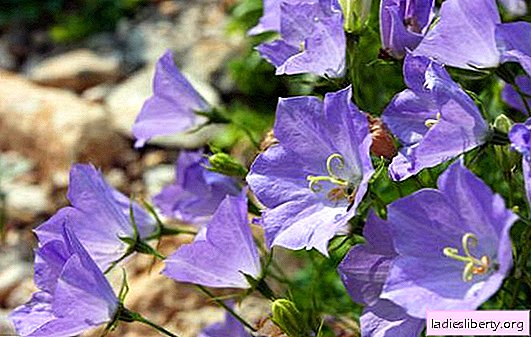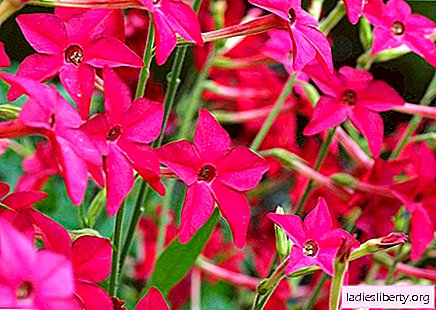
Bells are herbaceous plants whose flowers look like bells. They can often be found in the forests. Cultivated species are grown in the garden. A perennial bush is easily propagated by dividing the rhizomes, but if there is nowhere to take a favorite plant, you can acquire seeds and grow seedlings.
Let's look at how to do it right.
Sowing seeds of bluebells and growing seedlings, a photo of the process for beginners
If in the fall the seeds of bluebells are caught, then you can just sow them in the ground before winter. They do not require special preparation, seedlings will appear in the spring. But the likelihood that small seeds will simply stretch deep into the soil and will not rise is very large. Better to wait a bit and grow seedlings.
In the first decade of March, they begin work on seedlings. To do this, prepare the soil in advance. Use a loose, water-permeable substrate, the soil is suitable for seedlings of flowers. A pan is also prepared, it should not be too big.
Step-by-step instructions for growing bells from seeds:
1. Fill the container with soil, compact it slightly, moisten well with a spray bottle. Leave overnight to absorb moisture well.

2. Spread the seeds evenly over the surface, do not crush the ground. Sprinkle out of the spray gun. Cover the crops with foil.

For germination, bells need a temperature of +20 ° C. The plates are cleaned in a bright place. Shoots will appear in 2-3 weeks.
Caring for the seedlings of bells
Like any flower culture, the bell needs care. Delicate sprouts are very fragile, they can bend from drops of water, so they water the plants in a tray or on the walls of a bowl. You can apply spot irrigation, that is, water from a syringe into the gaps between seedlings.
The bell is demanding on soil moisture. The soil should be moist, but in moderation. If you overdo it, the seedlings will fall ill with a "black leg".
Seedlings are grown on the east window so that it has enough lighting. In the room, the plates are placed only with artificial lighting, without this the seedlings are drawn out. If the shoots are pulled out on the windows, but their leaves are green and healthy, you can use a little trick, crush them with earth. This must be done very carefully so that the sprouts do not die. For this purpose, use a fine sieve and loose soil. Through a strainer, the soil is evenly distributed over the seedlings; after watering, it itself will fall as it should. This method is used when growing seedlings from small seeds, which makes the sprouts more stable. You can add soil as the seedlings grow.

Bells are diving in the phase of the first true leaves. You can simply thin out the seedlings, leaving 1 plant per 10 cm of area, or plant them in separate containers. Beginners are recommended to sow more seeds than necessary and just thin out the seedlings.
Seedlings are fed two weeks after the pick, when it is fully adapted. Use liquid mineral fertilizer for flowering crops, its concentration is reduced so as not to burn delicate seedlings.
Transplanting bells into the ground for further cultivation
In unprotected soil, seedlings are transferred with the first warm days when the threat of night frost is over. But for this, plants are gradually accustomed to the environment. Start hardening seedlings after a dive, open the window for a short while, take it out into the air, gradually increase the time. Before planting, leave the seedlings to air all night. When the seedlings are ready, they are transplanted.
The landing site is chosen according to all the requirements of the culture. In the natural environment, bells prefer sparse lighting. In the garden, they can be planted under young trees, the crown of which is not too dense. From direct sunlight and draft, it is better to fence the plant.
The soil for the bells is prepared in advance. They dig it up, add humus and sand. Ideally, a loose, well-drained soil should be obtained. As drainage, you can use small stones, pebbles, etc.
Advice! Do not introduce fresh manure or peat before planting. These fertilizers contribute to fungal diseases.
There are no special secrets in planting and growing bells. Seedlings are planted depending on the variety. Tall varieties need a larger feeding area, so they leave up to 50 cm between them.
Outdoor bells care, transplantation and culture diseases
Garden bells are quite unpretentious plants. They will be able to grow a novice or a busy person who wants to decorate a flower bed. The bushes do not need special care, standard procedures are enough:
• watering as needed;
• weeding;
• top dressing.
It should be noted that the bells are watered rarely, only in the heat. In ordinary summer and spring, they have enough natural soil moisture. It remains only to remove weeds in time so that the plants are not affected by diseases and pests.
Grassy shrubs are fed twice a season: in early spring and in the first half of summer. In the spring, nitrogen fertilizers are used to get a good green mass. During the formation of buds, the plant is fed with potash fertilizers. They do not feed anymore. The bell blooms for a long time, but in order for the plant to remain decorative, it is necessary to remove dry bells in a timely manner.
Transplant and propagate the bells once every 3-5 years, unless otherwise stated in the description of the variety. There are species that need rejuvenation every 2 years. A transplant and division of the rhizome is done either in early spring or in autumn. The bush is dug up, cut into several parts and immediately planted in a new place. It is impossible to store delenki, their roots are too thin.

In relation to diseases, bells are very stable. They are rarely affected by pests. The only thing that can destroy the bush is the pathogenic microflora that accumulates in the soil. Therefore, plants need to be transplanted on a schedule. Among pests, slugs are annoyed by bells, especially in rainy weather, more often loosen the soil, sprinkle the soil with ground red pepper or crushed shells. Slugs have a very vulnerable abdomen; they will not pass through such protection.
How a bell winters in the garden
As soon as the cold begins, the shoots of the plant need to be cut low. The herbaceous shrub tolerates frosts and can winter without shelter. But heat-loving varieties are best covered with dry foliage or spruce branches. In the northern regions, sheltering bushes is a necessary measure. It is best to mulch the bush with humus, a layer of which is not less than 25 cm.
There are a lot of varieties of bells; they are grown to decorate the garden everywhere. Carefully study all the tips and tricks to avoid mistakes and enjoy the long-awaited flowering.











